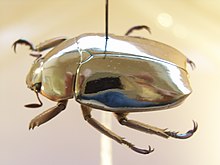Jewel scarab
| Jewel scarabs | |
|---|---|

| |
| Chrysina limbata | |
| Scientific classification | |
| Kingdom: | Animalia |
| Phylum: | Arthropoda |
| Class: | Insecta |
| Order: | Coleoptera |
| Family: | Scarabaeidae |
| Tribe: | Rutelini |
| Genus: | Chrysina Kirby, 1828 |
| Species | |
|
see text | |
| Synonyms | |
| |
| Wikispecies has information related to Jewel scarab. |
The ruteline genus Chrysina, or jewel scarabs (not to be confused with jewel beetles which are a different family), is a large genus of brightly colored, often metallic iridescent species, ranging from the southwestern edge of the United States as far south as Venezuela and Ecuador. The genus includes all the species formerly known as Plusiotis.[1] They are typically between 15–35 millimetres (0.59–1.38 in) in length, and are nocturnal in habits, coming readily to lights. The larvae live in rotting logs, while the adults commonly feed on foliage; they tend to be found in pine, juniper, or pine-oak forests, most commonly between 1,000–3,000 metres (3,300–9,800 ft) elevation. They are most diverse in countries such as Guatemala, where as many as 15 species can be found in a single location, but there are only 4 species which occur in the United States.[1]
These beetles are very popular among collectors; many species are polymorphic, with rare color variants that can command high prices. One such specimen was featured on the cover of National Geographic Magazine.[2] The majority of species are bright green, but metallic silver and gold are also common colors, and may be combined with green as in the common Chrysina gloriosa from the Madrean sky islands region.
Particularly attractive specimens were reported to sell for as much as $500 in 2007.[2]
Species[]
- (Hope, 1841)
- Chrysina adolphi Chevrolat, 1859
- Monzón, 2017
- (Hawks, 1995)
- (Morón, 1981)
- (Burmeister, 1844)
- Monzón, 2017
- Monzón, 2012
- (H. Bates, 1888)
- Chrysina aurigans (Rothschild & Jordan, 1894)
- Perez-Flores, Villagomez & Galindo, 2016
- Gray, 1832
- (Morón, 1981)
- (Ohaus, 1913)
- (Boucard, 1875)
- (Boucard, 1878)
- Monzón, 2010
- (Boucard, 1875)
- H. Bates, 1889
- Pokorný & Curoe, 2012
- Chrysina beraudi (Warner, Hawks & Bruyea, 1992)
- Chrysina beyeri (Skinner, 1905)
- Monzón & García, 2011
- Chrysina boucardi (Sallé, 1878)
- (Rothschild & Jordan, 1894)
- (Hawks, 1999)
- Hawks & Bruyea, 1999
- (Morón, 1990)
- (H. Bates, 1888)
- Mora-Aguilar, Curoe, Delgado & Ramírez-Ponce 2018
- (H. Bates, 1888)
- (Sallé, 1874)
- (H. Bates, 1888)
- (Blackaller-Bages & Delgado, 1994)
- Monzón, Blackaller, & Hawks, 2020
- (Rothschild & Jordan, 1894)
- (Morón, 1992)
- (Ohaus, 1913)
- (Blanchard, 1850)
- (Rothschild & Jordan, 1894)
- (Curoe, 1999)
- (F. Bates, 1904)
- (Warner, LeBlanc, Hawks & Bruyea, 1992)
- (Curoe, 1994)
- (Ratcliffe & Taylor, 1992)
- (Morón, 1990)
- (Ohaus, 1912)
- Monzón & García, 2011
- (Arnaud, 1994)
- (Monzón & Cano, 1999)
- H. Bates, 1889
- (Ohaus, 1913)
- Curoe, 2012
- Hawks, 2017
- (Ohaus, 1905)
- Curoe, 2012
- Hawks, 2017
- Monzón, 2010
- Chrysina gloriosa (Leconte, 1854)
- Delgado, 2003
- (Monzón, Cano & Bailey, 1999)
- (Curoe, 2001)
- (Morón, 1990)
- Monzón, 2010
- (Morón, 1990)
- (Ohaus, 1913)
- Hawks, 2017
- Zubov & Ivshin, 2019
- (Nonfried, 1891)
- (Boucard, 1875)
- (Sturm, 1843)
- Chrysina lecontei (Horn, 1882)
- Chrysina limbata (Rothschild & Jordan, 1894)
- (Ohaus, 1913)
- (Francillon, 1795)
- (Morón, 1990)
- Monzón, 2017
- (Waterhouse, 1871)
- Nogueira & Curoe, 2012
- (Morón, 1990)
- (Sturm, 1843)
- (Curoe & Beraud, 1994)
- (Morón, 1992)
- Curoe, 2011
- (H. Bates, 1888)
- (Morón, 1992)
- (H. Bates, 1889)
- (Curoe, 1994)
- Hawks, 2017
- (Ohaus, 1930)
- Kirby, 1828
- (Ohaus, 1912)
- Monzón & Hawks, 2020
- (Boucard, 1878)
- Hawks, 2020
- (Morón & Howden, 1992)
- (Sturm, 1843)
- (Morón, 1990)
- (Monzón & Warner, 1993)
- (Morón, 1990)
- (Morón, 1990)
- (Morón, 1990)
- Chrysina resplendens (Boucard, 1875)
- Hawks, 2020
- (Boucard, 1878)
- Hawks, 2017
- (Boucard, 1875)
- (Monzon, Cano & Bailey, 1999)
- (Solís & Morón, 1995)
- (Ratcliffe & Jameson, 1992)
- (Ohaus, 1924)
- (Morón, 1992)
- (Morón, 1990)
- (Cano & Morón, 1995)
- (Morón, 1990)
- (Morón & Nogueira, 2016)
- (Ohaus, 1922)
- Morón, 1990
- (Ohaus, 1913)
- Zubov & Ivshin, 2019
- (Ohaus, 1922)
- (Hope, 1841)
- (Ohaus, 1912)
- Chrysina woodi (Horn, 1884)
- Monzón, 2017
- (Morón, 1992)
- (Morón, 1990)
References[]
- ^ a b Hawks, D.C. 2001. Taxonomic and nomenclatural changes in Chrysina and a synonymic checklist of species (Scarabaeidae: Rutelinae). Occ. Papers Consort. Coleopt. 4: 1-8
- ^ a b "Jewel Scarabs". National Geographic. 2007-02-07. Archived from the original on 2007-02-07. Retrieved 2018-08-19.
External links[]
- Rutelinae
